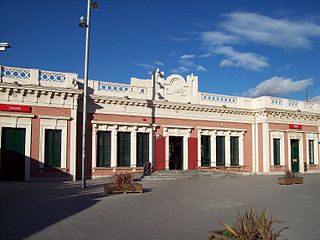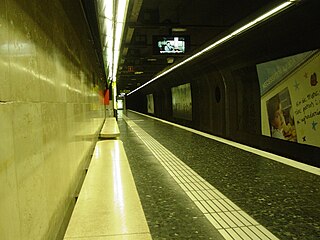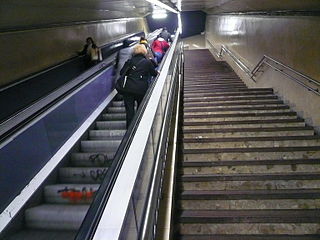
The Trambaix is one of Barcelona's three tram systems. It is operated by TRAMMET connecting the Baix Llobregat area with the city of Barcelona, Catalonia, Spain. It opened to the public on 5 April 2004 after a weekend when the tram could be used free of charge.

Trambesòs is a tram–light rail system in the Spanish autonomous community of Catalonia that links the Barcelona district of Sant Martí with Badalona and Sant Adrià de Besòs. Its name comes from the union of the words "tram", an abbreviation of the Catalan word for "tram" (tramvia), and "Besòs", the name of an area in the north of the Barcelonès region dominated by the Besòs River.

Avinguda Diagonal is the name of one of Barcelona's broadest and most important avenues. It cuts the city in two, diagonally with respect to the grid pattern of the surrounding streets, hence the name.

Provença is the name of a Ferrocarrils de la Generalitat de Catalunya station located under Avinguda Diagonal and Balmes street. The station is served by FGC-operated Barcelona Metro lines L6 and L7, and Metro del Vallès suburban metro lines S1 and S2. Diagonal is the name of an important station in TMB-operated Barcelona Metro network. It is named after Avinguda Diagonal, where the station is located together with Passeig de Gràcia. It is served by TMB-operated Barcelona Metro lines L3 and L5, and it is also connected with FGC station.

Plaça d'Espanya, also simply known as Espanya, is an interchange complex underneath Plaça d'Espanya, in the Barcelona district of Sants-Montjuïc, in Catalonia, Spain. It comprises the Barcelona terminus of the Llobregat–Anoia Line and a Barcelona Metro station complex served by lines 1 (L1) and 3 (L3). On the L1, the station is between Hostafrancs and Rocafort, and on the L3 it is between Poble Sec and Tarragona. The Llobregat–Anoia Line station is served by Barcelona Metro line 8 (L8), Baix Llobregat Metro lines S33, S4 and S8, and commuter rail lines R5, R6, R50 and R60. The services on the Llobregat–Anoia Line are operated by Ferrocarrils de la Generalitat de Catalunya (FGC), whilst the L1 and L3 are operated by Transports Metropolitans de Barcelona (TMB).

Zona Universitària is a station in the Barcelona Metro and Trambaix networks, in the Les Corts district of Barcelona. It is currently the western terminus of metro line L3 and L9. Also it's served by tram lines T1, T2 and T3. It is named after the Universitat de Barcelona campus of the same name.

Cornellà Centre, also simply known as Cornellà, is a Rodalies de Catalunya and Barcelona Metro station, as well as Trambaix tram stop. It is located in the city centre of the Cornellà de Llobregat municipality, to the south-west of Barcelona, in Catalonia, Spain.

Marina is a station in the Barcelona Metro and Trambesòs tram networks, at the boundary between the Eixample and Sant Martí districts of Barcelona. It is served by TMB line L1 and tram route T4. The station is named after the nearby Carrer de la Marina, and can be accessed from Carrer dels Almogàvers, and the crossing of Carrer de la Marina with the Avinguda Meridiana. It is adapted for disabled people.

Vall d'Hebron | Sant Genis is a Barcelona Metro station, in the Horta-Guinardó district of Barcelona, and named after the nearby Vall d'Hebron neighbourhood. The station is served by line L3 and is the northern terminus of line L5.

Sants Estació is a station in the Barcelona Metro network in the Sants-Montjuïc district of Barcelona. It serves the Barcelona Sants railway station, Barcelona's principal main line railway station, and is named Sants Estació to distinguish it from the nearby Plaça de Sants station also named after the Sants neighbourhood. It is served by line L3 and line L5.

Gorg is a Barcelona Metro and Trambesòs complex named after the neighbourhood of the same name where the station is situated, in Badalona municipality. It is located on Avinguda del Marquès de Mont-Roig and very close to Palau Municipal d'Esports de Badalona, the home arena of the professional basketball club Joventut de Badalona. It is served by TMB-operated Barcelona Metro lines L2 and L10, and Trambesòs route T5.

Plaça de Francesc Macià is a square in Barcelona, Catalonia, Spain. Located in one of the main business areas of the city, it is one of the most transited points of Barcelona. It is crossed by Avinguda Diagonal and several other major thoroughfares: Avinguda de Josep Tarradellas, Travessera de Gràcia, Carrer del Comte d'Urgell and Avinguda de Pau Casals. It is part of the Sarrià-Sant Gervasi district, even though it borders two other districts of Barcelona: Les Corts and Eixample.

Poble Sec is a station of the Barcelona Metro network located in the neighbourhood of the same name, in the district of Sants-Montjuïc, Barcelona. It is served by L3, and was previously known as Parlamento.

The Tramvia Blau is one of Barcelona's three tram systems. It is a 1.276 kilometres (0.793 mi) long heritage streetcar line serving a hilly area of the Sarrià-Sant Gervasi district between the terminus of FGC Barcelona Metro L7 and the Funicular del Tibidabo.

Avinguda Carrilet, also known as L'Hospitalet Avinguda Carrilet, is an interchange complex underneath Avinguda Carrilet in the L'Hospitalet de Llobregat municipality, to the south-west of Barcelona, in Catalonia, Spain. It consists of a railway station on the Llobregat–Anoia Line and a Barcelona Metro line 1 (L1) station. The Llobregat–Anoia Line station is served by Barcelona Metro line 8 (L8), Baix Llobregat Metro lines S33, S4 and S8, and commuter rail lines R5, R6, R50 and R60. The services on the Llobregat–Anoia Line are operated by Ferrocarrils de la Generalitat de Catalunya (FGC), whilst the L1 is operated by Transports Metropolitans de Barcelona (TMB).

Vallcarca is a Barcelona Metro station in the Vallcarca i els Penitents neighbourhood, in the Gràcia district of Barcelona.The station is served by line L3.

Plaça del Centre, also known as Plaza del Centro, is a station in the Barcelona Metro network, on the border between the Les Corts and Sants-Montjuïc districts of Barcelona. It is served by line L3.

Maria Cristina is a station in the Barcelona Metro and Trambaix networks, in the Les Corts district of Barcelona. It is served by metro line L3 and tram lines T1, T2 and T3.
The Diagonal line of the Barcelona Metro network was a proposed underground railway service in the Spanish city of Barcelona. The proposal was made by Transports Metropolitans de Barcelona (TMB) between 1989 and 1992. It would have been a line crossing the city's most important avenue, Avinguda Diagonal, from southwest to northeast, through central Barcelona. However, the project was finally abandoned.

Historically, the city of Barcelona, in the Spanish autonomous community of Catalonia, had a large tramway network. The city's first tram line opened in 1872, but almost all of these historic lines had closed by 1971, being replaced by buses and by the expanding Barcelona Metro. The one remaining line, the Tramvia Blau, was retained as tourist attraction, using historic rolling stock. However at the beginning of the 21st century, two new tram systems, the Trambaix and Trambesòs, opened in the suburbs of the city.





















